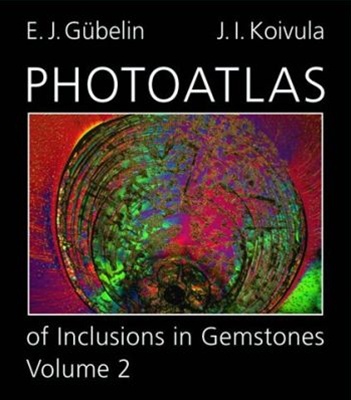Gübelin, Eduard J. & Koivula, John I. (2005) Photoatlas of Inclusions in Gemstones, Volume 2. Opinio Publishers, Basel, Switzerland, 830 pp. ISBN 978-3855040957
The authors of this book need no introduction. Quite simply, they are two of the most prominent gemologists of the past 100 years. Nearly two decades after the release of their magnum opus, Photoatlas of Inclusions in Gemstones, comes Photoatlas of Inclusions in Gemstones, Volume 2.
I have now had my hands round a copy for a few days and can testify that superlatives are entirely inadequate. I love this book! This companion not only matches, but exceeds the work of Volume 1. And with Volume 3 published in 2006, what we now have is one incredible body of work, on the order of Goldschmidt's nine-volume Atlas der Krystallformen or John Sinkankas' bibliographic tour-de-force, Gemology. It is such a pity that Eduard Gübelin passed away shortly before publication, for these volumes represent the capstone on an amazing career.
|
Tale of the Tape Opinio Publishers, Basel, Switzerland Chapter Contents
I. Introductory Section
II. Thematic Section
III. Characteristics of Inclusions
IV. Inclusions in Gems of Commercial Importance
In Conclusion Glossary of Scientific Expressions Index About the Authors |
Size matters
While the original Photoatlas was large at 532 pages, Son of Photoatlas is an even bigger boy, tipping the scales at a massive 830 pages, nearly 40% more. Sadly, just like Volume 1, the publisher chose to stuff Cartier-quality scholarship into a K-Mart binding. This is all the more shocking considering the extra weight that needs to be supported. The result is a disaster, certainly not up to the fine craftsmanship we expect from Swiss-made products.
Free the fractures
The book begins with an introductory section, where the term "inclusion" is defined. One item that struck me as a bit odd was the statement on page 18 that "An inclusion is any optically detectable irregularity other than a crack observed within a gem material." This concept is driven home on page 23, where the caption for a deliciously iridescent fracture in a Brazilian aquamarine baldly states that "it is not an inclusion."
Huh? If that baby ain't an inclusion, then what the heck is this cheap trollop doing prancing across the page, absent even the slightest modicum of shame?
And what of the topaz on page 16? How can cleavage that gorgeous ever be considered a "flaw?" Why have we allowed these optically delectable irregularities to become the pariahs of the inclusion community? How can we sit idle while virtually the entire inclusion population cavorts across the internal world – absent any and all restraint – and then allow the authorities to slap a burka on just fractures and other free-spirited breaks? What's next, witch burning? I say free the fractures, free the fractures!
History, etc.
An extremely brief section is devoted to the history of inclusion research. This reviewer would liked to have seen the section fleshed out a bit further, since it provides only brief mention of the work of a few early researchers such as David Brewster, and entirely ignores that of those like al-Biruni and others. A more comprehensive bibliography would also have been a nice touch.
The book continues with an extremely useful section describing both microscopic techniques and analytical methods before diving into a number of chapters on individual gems. The former might have benefited from some additional diagrams and illustrations. While these drawings are present in Volume 1, a few here would have been a welcome addition.
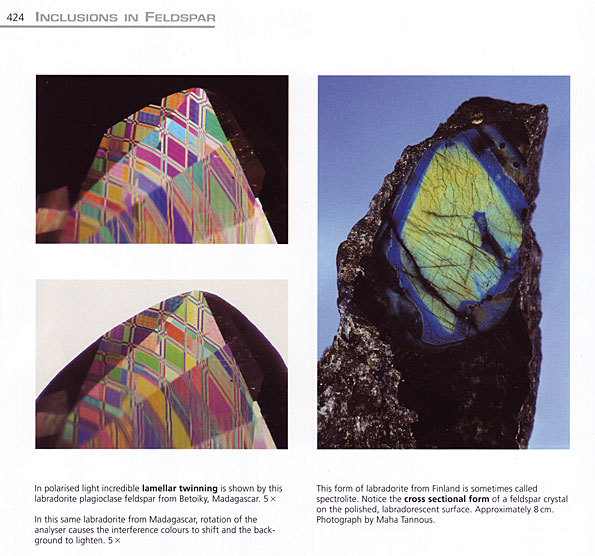 Who would have imagined that the most common mineral on the planet could be so beguiling? Feldspar, page 424.
Who would have imagined that the most common mineral on the planet could be so beguiling? Feldspar, page 424.
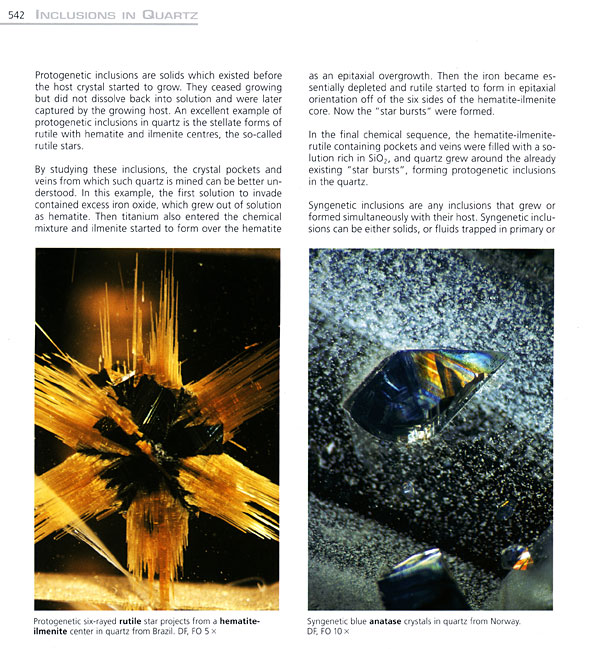 While the text of the Photoatlas is minimal, it provides concise and important information that substantially adds to the book's value. Quartz, page 424.
While the text of the Photoatlas is minimal, it provides concise and important information that substantially adds to the book's value. Quartz, page 424.
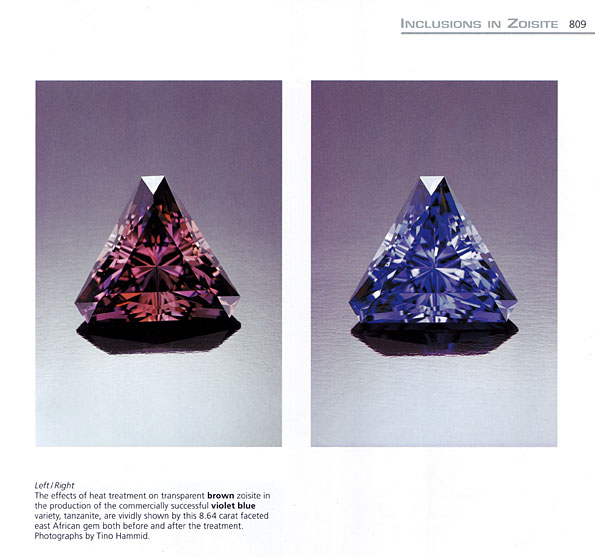 The effects of heat treatment on zoisite (tanzanite). Page 809.
The effects of heat treatment on zoisite (tanzanite). Page 809.
Eye candy
But I doth protest too much. The Photoatlas series is about the show, not the tell – it's about images, and they are here in spades, some 2200 of them, page after page of beauties that left this reader in serious down-on-his-knees-slobbering-in-admir… how-the-heck-didya-grab-that-shot… idol worship. God how I love this book!
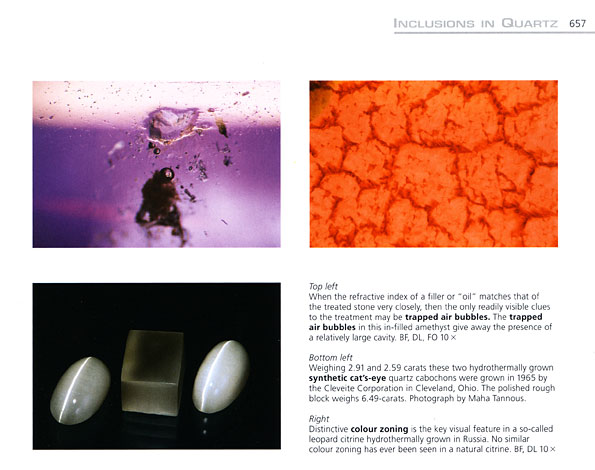 Synthetic and treated gems are also given their due. Quartz, page 657.
Synthetic and treated gems are also given their due. Quartz, page 657.
One of the joys of the Photoatlas series (and much of Gübelin & Koivula's work) is that – beyond the rigorous scientific documentation and analysis – it also operates on an entirely different plane, that of aesthetic and stylistic beauty. It is shocking that so few gemological books or magazines reach for this higher goal, particularly considering the importance of aesthetics in this field. Bravo to both authors for having both courage and talent to mine this little-touched vein.
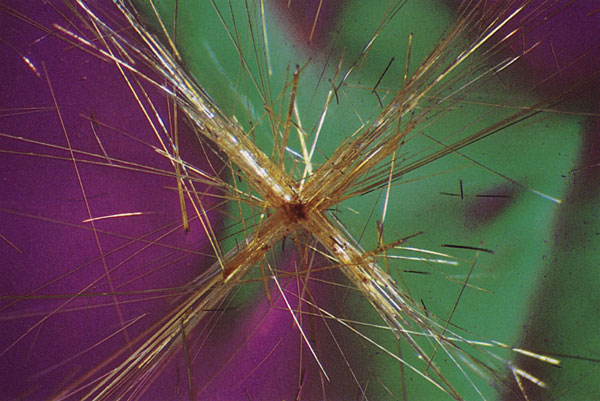 Pickup sticks Like the forces of creation captured milliseconds after combustion, twinned rutile explodes amidst a matrix of interference colors. Quartz, page 631.
Pickup sticks Like the forces of creation captured milliseconds after combustion, twinned rutile explodes amidst a matrix of interference colors. Quartz, page 631.
As evinced by the twinned rutile above, many images stand alone as genuine works of art. Like a fine painting or piece of music, time spent in their presence continually yields new revelations. While I browsed the newest Photoatlas, I recalled the delight an image of moss agate from Volume 1 brought when I realized – years later – what the photographer was alluding to. Since this is an all-ages review, I won't give away any secrets, but rest assured, Volume 2 offers further panoramas of serendipitous discovery. Did I mention that I love this book?
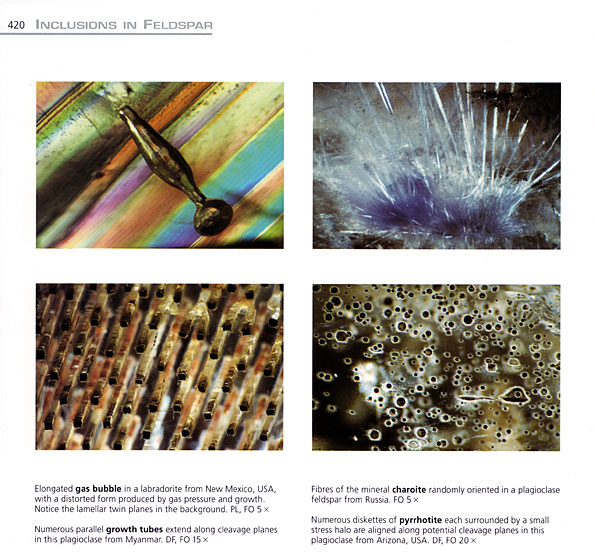 A typical page from the Photoatlas of Inclusions in Gemstones, Volume 2, showing the stunning imagery found betwixt its covers. Feldspars, page 420.
A typical page from the Photoatlas of Inclusions in Gemstones, Volume 2, showing the stunning imagery found betwixt its covers. Feldspars, page 420.
Free your eyes (and your mind will follow)
Witness just the single leaf on feldspar above (page 420), entirely representative of the whole. Four images, each a micromasterpiece. Indeed, if this book has a flaw, it is that so many photographs are a wee bit small as reproduced. Hundreds deserve to be blown up to full-page or even poster size, so we can fully appreciate their majesty.
But why waste breath explaining the obvious. If ever there was a book deserving of contemplation, it is this. So let us pause for a moment to exhale banal intellect for intellect's sake, science as simpletonian yardstick, purge the very notion of precious objects as hood ornaments of wealth.
Finished? Now inhale something different. Life. Drink deep. Let your eyes and mind awake, let them roam across the pages sucking in, rather than breathing out. Challenge your psyche with the complex beauty, tease your heart with the sublime wonders of creation, let both join together, reality and illusion. And as they mix, savor the joys of life and living and the beauty of our world as manifest in this magnificent piece of scholarship.
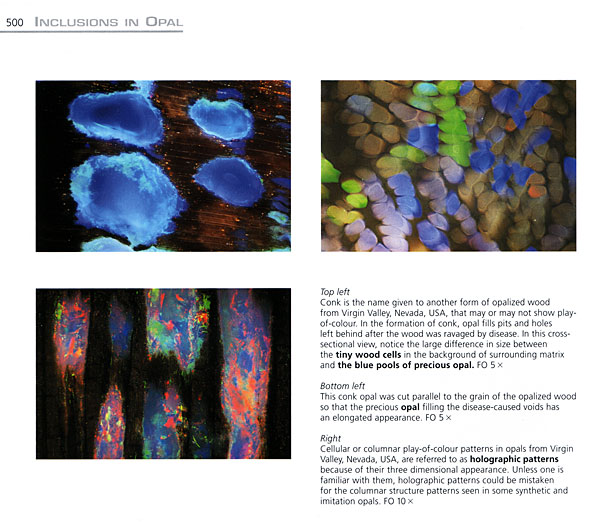 The beauty of opal is amply illustrated in the new volume. Page 500.
The beauty of opal is amply illustrated in the new volume. Page 500.
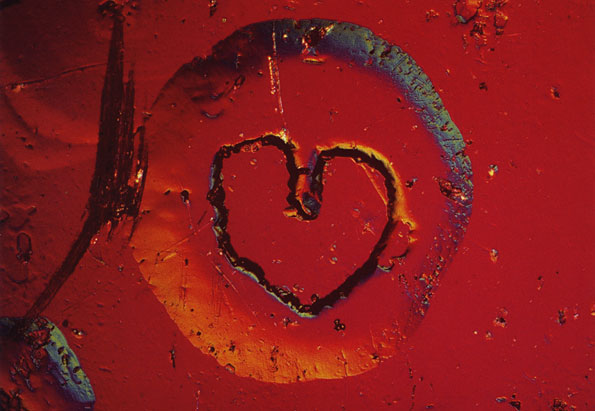 This serendipitous heart-shaped hillock in morganite graces the dedication page.
This serendipitous heart-shaped hillock in morganite graces the dedication page.
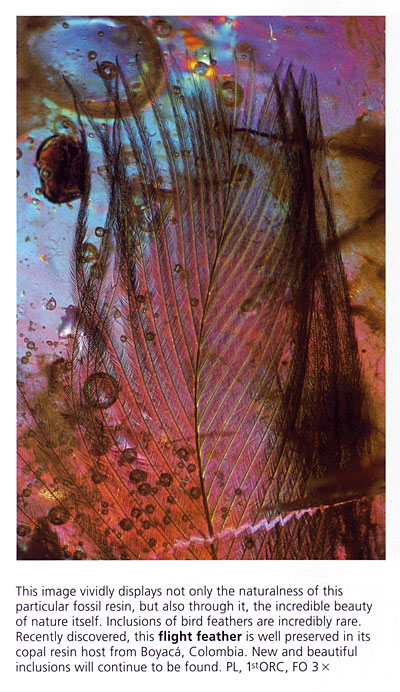 A feather for our thoughts. Fossil resin, page 812.
A feather for our thoughts. Fossil resin, page 812.
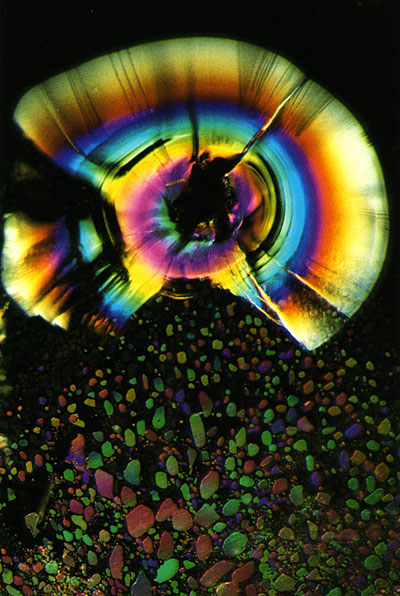 The iridescent aura of a stress fracture extends outward from a solid inclusion, while an audience of liquid droplets bows in reverence below. Beryl, page 326.
The iridescent aura of a stress fracture extends outward from a solid inclusion, while an audience of liquid droplets bows in reverence below. Beryl, page 326.
Love, devotion, surrender
This volume is a study in meditation. With the publication of the new volumes of the Photoatlas series, gemology will now be classed into two eras – Before and After Photoatlas. Welcome to the AP era. If you consider yourself a gemologist, or aspire to become one, you must have these volumes on your shelf. It's that simple.
Love, devotion… I surrender. Eddie & Johnny – you've done a heckuva job!

Postscript – Lending a hand
As a published author myself, I can tell you that authors' royalties in no way offset the cost of producing such work. For example, while this volume was nearly two decades in the making, the authors probably earn but a few bucks per copy.
Readers have a chance to change that. Co-author John Koivula and his wife, Kristi, are acting as a distributor for this book through their stunning website, microWorld of Gems. This gives us a unique opportunity to directly support an author. The publisher still gets their due, but by purchasing direct, you put a bit of extra coin in the pocket of the author, money that will help fund future work of this type.
Autographed copies can be purchased directly through John and Kristi Koivula's microWorld of Gems. I highly recommend that if you do purchase this book, you do so via the creator's company. High-quality Giclee enlargements of many of Koivula's photos are also on sale there.
Bias watch
I should mention that I work with one of the authors (JK) and he is a close friend. While you ponder that, I'll close with this: if the publisher wants the review copy back, they'll have to pry it from my cold dead hands.

